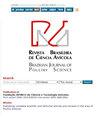饲粮中添加锌、锰、铜及不同植酸酶水平对肉仔鸡血清及骨酸碱性磷酸酶的影响
IF 1.1
4区 农林科学
Q3 AGRICULTURE, DAIRY & ANIMAL SCIENCE
引用次数: 0
摘要
本文章由计算机程序翻译,如有差异,请以英文原文为准。
Effects of Supplementation of Zinc, Manganese, or Copper and Different Phytase Levels in Serum and Bone Acid and Alkaline Phosphatases of Broiler Chicks
The knowledge of biological trace minerals and phytase requirements for modern broiler genotypes is not established and the pressure to reduce their usage in animal feeding due to environmental issues is increasing. Here, the alkaline phosphatase (ALP) and tartarate-resistant acid phosphatase (TRAP) of the tibia and serum of broilers fed with diets containing various levels of phytase and reduced levels of zinc, manganese, and copper was evaluated. The experiment was performed using 1,200 male Cobb broilers raised according to standard commercial husbandry techniques. Data were analyzed as a 4×3 factorial arrangement with four concentrations of zinc (0.34, 0.49, 0.64, and 0.79 ppm), manganese (0.18, 0.43, 0.68, and 0.93 ppm), or copper (0.09, 0.12, 0.15, and 0.18 ppm) and three concentrations of phytase (0, 500, and 1,000 FTU/kg) for age periods of 1-21 and 36-42 days. While the dietary supplementation with copper did not induce a significant effect in bone tissue biochemical markers, serum TRAP activity of 42-day old broilers increased with higher copper levels. Increasing dietary zinc levels linearly increased ALP activity in tibia growth, suggesting that zinc is essential for longitudinal bone growth. Phytase significantly promoted the increase of TRAP
求助全文
通过发布文献求助,成功后即可免费获取论文全文。
去求助
来源期刊

Brazilian Journal of Poultry Science
农林科学-奶制品与动物科学
CiteScore
1.80
自引率
9.10%
发文量
60
审稿时长
>12 weeks
期刊介绍:
A Revista Brasileira de Ciência Avícola surgiu em 1999 a partir da necessidade que a comunidade científica possuía de um periódico para veiculação e publicação de seus trabalhos, com a publicação de três números anuais.
A Revista conta hoje com um corpo editorial altamente qualificado e com artigos científicos desenvolvidos pelos maiores especialistas da área, o que a cada dia atrai mais leitores em busca de inovação e respaldo técnico.
Devido à credibilidade que conquistou pelos esforços de sus autores, relatores e revisores, a Revista ganhou caráter de coleção, sendo consultada como fonte segura de estudo desenvolvidos na Avicultura.
A partir de 2003 – volume 5 -, a Revista passou a chamar-se Brazilian Journal of Poultry Science, e todos os trabalhos passaram a ser publicados em inglês. No mesmo ano subiu para quatro o número de revistas por volume, ampliando-se assim os trabalhos publicados anualmente.
 求助内容:
求助内容: 应助结果提醒方式:
应助结果提醒方式:


